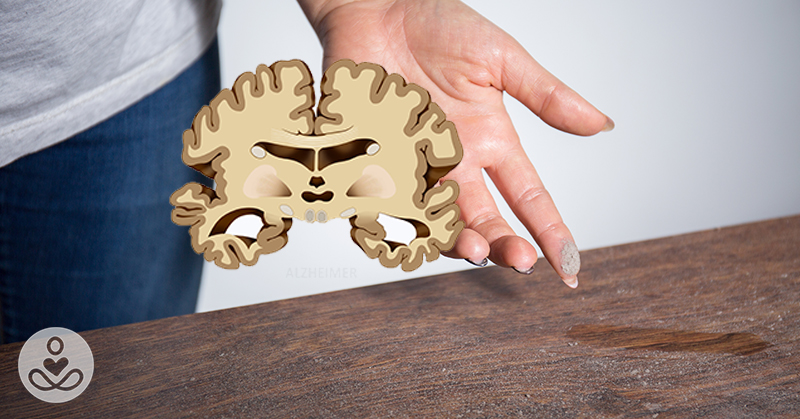Air pollution is a well-known danger to our health, with studies linking it to respiratory diseases, cardiovascular issues, and even premature death. However, what many people are unaware of is the connection between air pollution, Alzheimer’s disease, and cancer. In addition to the outdoor pollutants that we often associate with air pollution, indoor dust also plays a significant role in this complex relationship. This article aims to shed light on the lesser-known link between air pollution, Alzheimer’s disease, and cancer, and how it is connected to the dust in our homes that we often underestimate.
What is indoor dust made of? (It’s more than just dirt)

When we think of dust, we tend to imagine small particles of dirt and lint floating in the air or gathering on surfaces. While this is true, the composition of dust can be much more complex than we realize. Tiny fibers from our clothing, lint that flakes from carpets and furniture, skin cells, fibers of human and pet hair, and various other small particles can be found floating around our homes or lurking beneath our furniture.
According to Paloma Beamer, Ph.D., an associate professor in the school of Public Health at the University of Arizona, approximately one-third of the dust in our homes comes from indoor inorganic sources. The remaining two-thirds come from soil and outdoor air particles that are tracked inside. This means that the dust we encounter indoors is not just a harmless collection of dirt and lint but can contain a wide range of potentially harmful substances. (1)
Read More: Effects of THC on Damaging Alzheimer’s Proteins
The dangers of dust exposure

Research published in the journal Environmental Science and Technology has shed light on the hidden dangers of dust exposure. This study evaluated data from 25 prior studies and revealed that there are more than meets the eye when it comes to the particles in our indoor dust. Two classes of chemicals were found to be present in high concentrations in dust: phthalates and highly fluorinated chemicals (HFCs). (2)
Phthalates, commonly used as plasticizers in various consumer products, have been linked to endocrine system disruption, decreased IQ, and respiratory problems. These chemicals can enter our bodies through inhalation or ingestion when they become airborne or settle on surfaces.
HFCs, on the other hand, have been associated with increased risks of testicular and kidney cancers. These chemicals are often found in everyday items such as furniture, carpets, and food packaging. When released into the air as dust, they can easily be inhaled or absorbed through the skin, posing a significant risk to our health.
The connection between dust, air pollution, and Alzheimer’s disease

While the direct link between air pollution and Alzheimer’s disease is still being studied, there is evidence to suggest that exposure to certain types of dust can exacerbate cognitive impairment. One particularly significant study conducted by researchers at Mount Sinai found that exposure to World Trade Center dust worsened cognitive impairment in an animal model of Alzheimer’s disease. The terrorist attacks of 9/11 led to intense fires, which produced large, dense clouds of debris, particles, and toxic gasses. These became known as World Trade Center Particulate Matter (WTCPM). People such as first responders who spent long hours at Ground Zero had lengthy exposure to these chemicals and have since experienced certain chronic health conditions. (3)
“It is imperative that we understand the risk for Alzheimer’s disease in aging first responders and other subjects exposed to Ground Zero so that we can develop preventive initiatives,” said Giulio Maria Pasinetti, MD, PhD, the Saunders Family Professor of Neurology and Program Director for the Mount Sinai Center for Molecular Integrative Neuroresilience at Icahn Mount Sinai and senior author of the paper.
The study’s findings highlight the potential role of particulate matter in air pollution, including dust, in accelerating cognitive decline. The presence of toxic substances in indoor dust, combined with air pollution, may contribute to the development or progression of Alzheimer’s disease.
The University of California Study

A 2019 study conducted by researchers at the University of Southern California (USC) has revealed a significant connection between air pollution, memory problems, and Alzheimer’s-like brain changes. The study focused on women in their 70s and 80s and found that those who were exposed to higher levels of fine particle pollution (PM2.5 particles) experienced greater declines in memory and showed signs of brain atrophy similar to Alzheimer’s disease. This nationwide study, published in the journal Brain, not only sheds light on the importance of reducing the risk of Alzheimer’s disease but also suggests a potential mechanism for the development of the disease. By understanding the underlying brain changes caused by air pollution, researchers hope to develop interventions to help individuals with or at risk for cognitive decline. (4)
The study utilized brain scans and environmental data from 998 women aged 73 to 87. These scans were assessed using a machine learning tool trained on brain scans of individuals with Alzheimer’s disease, allowing the researchers to identify similarities to Alzheimer’s disease patterns. The analysis revealed a clear association between higher pollution exposure, brain changes, and memory problems, even after adjusting for various factors such as income, education, race, geographic region, and smoking. The findings provide valuable insight into the impact of air pollution on brain health and further our understanding of the Alzheimer’s disease epidemic. This study highlights the urgent need to address air pollution as a significant risk factor for cognitive decline and Alzheimer’s disease, and encourages further research into potential interventions and prevention strategies.
Read More: Alzheimer’s Can Be Transmitted Person to Person
The University of Technology, Sydney Study

A study published in Environment International by researchers from the University of Technology Sydney (UTS) and collaborating institutions has revealed a concerning link between tiny magnetic particles in air pollution and the development of Alzheimer’s disease. The study, led by Associate Professors Cindy Gunawan and Kristine McGrath, investigated the impact of air pollution on brain health in both mice and human neuronal cells in the lab. Through their research, the team found that magnetite, a magnetic iron oxide compound commonly present in air pollution from sources like vehicle exhaust and combustion processes, induced significant Alzheimer’s disease pathologies in mice. The exposure to fine particles of iron, magnetite, and diesel hydrocarbons over four months led to the loss of neuronal cells in crucial brain areas, amyloid plaque formation, behavioral changes consistent with Alzheimer’s disease symptoms, and an immune response triggering inflammation and oxidative stress, factors known to contribute to dementia. (5)
Moreover, the study findings suggest that the presence of magnetite particles in the brain can result in early-onset Alzheimer’s symptoms, regardless of the initial health state. This highlights the importance of reducing exposure to air pollution to mitigate the risk of neurodegenerative disease. The researchers observed that magnetite can enter the brain through the nasal passage and olfactory bulb, bypassing the blood-brain barrier and triggering an immune response that leads to neurodegeneration. The study’s implications extend to health practitioners and policymakers, emphasizing the need to consider magnetite particles in air pollution guidelines and implement measures to reduce emissions from vehicles, power stations, and other sources contributing to poor air quality. By addressing air pollution and improving air quality standards, it may be possible to prevent or mitigate the development of Alzheimer’s disease and other neurodegenerative conditions associated with exposure to harmful particles in the air.
What to do about dust in your home and minimize your risk

Given the potential dangers associated with dust exposure, it is crucial to take steps to reduce the risk in our homes. Here are some measures you can take to minimize dust levels and protect your health:
- Regularly vacuum and dust surfaces: Use a vacuum with a HEPA filter to effectively remove dust from carpets, furniture, and other surfaces. Dusting surfaces with a damp cloth will also help capture and remove particles.
- Control indoor humidity: High humidity levels can promote dust mite growth. Use dehumidifiers or air conditioners to keep the humidity levels between 30-50%.
- Use air purifiers: Air purifiers with HEPA filters can help capture and remove dust particles from the air, improving indoor air quality.
- Practice good hygiene: Regularly wash bedding, curtains, and other fabrics to minimize dust accumulation. Additionally, personal hygiene practices like washing hands frequently, especially before meals, can help reduce the intake of dust particles.
- Remove shoes at the entrance: Removing shoes before entering your home will prevent outdoor dust and pollutants from being tracked inside.
- Ventilate your home: Open windows and use exhaust fans in the kitchen and bathroom to promote air circulation and reduce the concentration of dust particles.
The Bottom Line

The connection between air pollution, Alzheimer’s disease, and cancer is a complex and often overlooked aspect of our health. The silent culprit hiding in plain sight is the dust in our homes, which can contain harmful chemicals and contribute to the worsening of various health conditions. By understanding the composition of indoor dust, recognizing the dangers of dust exposure, and taking appropriate measures to reduce dust levels, we can minimize our risk and create a healthier living environment for ourselves and our loved ones.
Read More: Brain Autopsies Show Possible Culprit Behind Alzheimer’s Disease
Sources
- “Dust Particles Are Probably Quite Toxic.” Southwest Environmental Health Sciences Center. September 28, 2016.
- “Effect of dust formation on the fate of indoor phthalates: Model analysis.” Science Direct. Runjie Li, Lingyi Kang, Sijing Wu, Xiaojun Zhou and Xinke Wang. February 2023.
- “Exposure to World Trade Center Dust Exacerbates Cognitive Impairment in an Animal Model of Alzheimer’s.” Mount Sinai
- “USC study connects air pollution, memory problems and Alzheimer’s-like brain changes.” Today. Leigh Hopper. Novemver 20, 2019.
- “Tiny magnetic particles in air pollution linked to development of Alzheimer’s.” Sceince Daily. University of Technology Sydney. February 29, 2024

